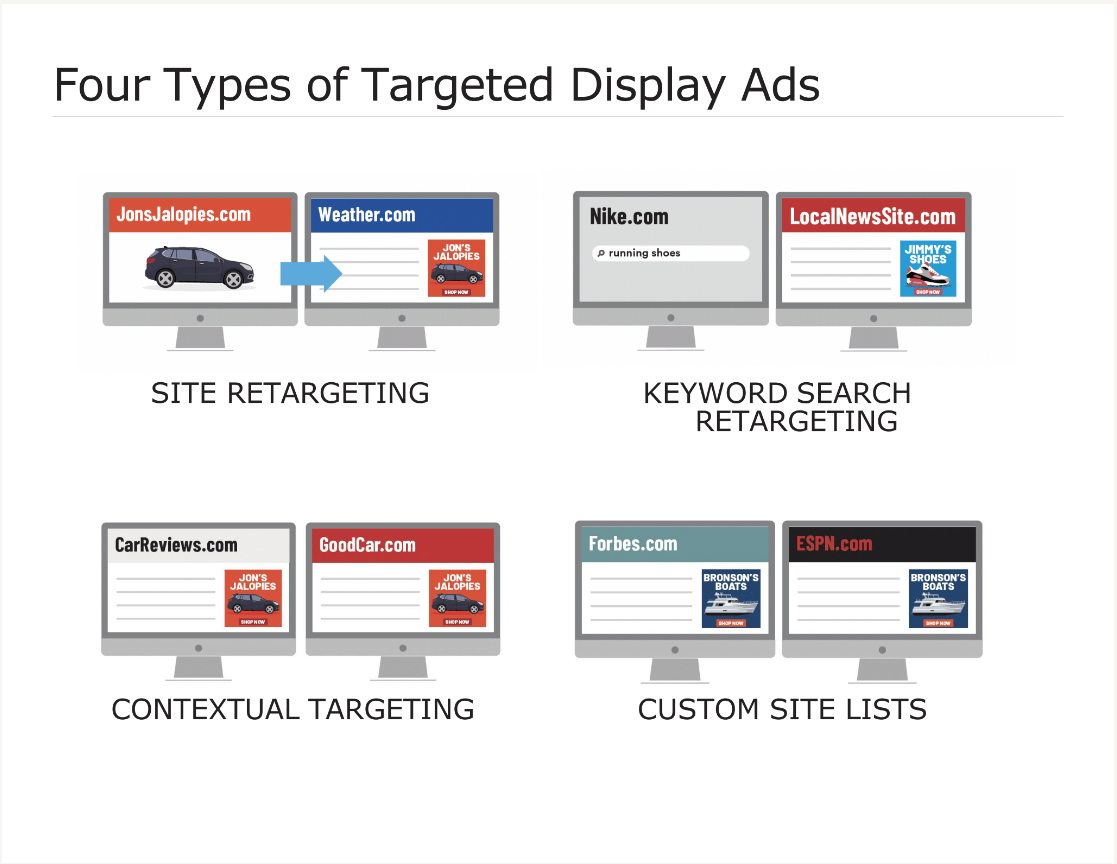
When it comes to digital marketing there are a wide range of tactics to use to reach customers. One of the most popular ways to advertise digitally is with targeted display. Targeted display ads are images, and usually contain text and a call to action. These types of ads can display on a wide range of sites across the web. Overall, targeted display is great for businesses looking to build brand awareness or to promote a very visual product. One of the best things about targeted display is the flexibility we have in how we target our audience. In this blog, we will be talking about the four types of targeted display we use and when each one is the best fit.

Site Retargeting
- What is it: Serving ads to users who have already visited a website. It’s a great way to reach an audience that has already shown interest in a product or service.
- How we use it: Retargeting can be a good fit for a majority of clients that are able to place tracking code on their website. This is a great way for brands to get a message back out to people who have already interacted with a website or even a specific page of a website.
- Who it’s a good fit for: We have found that retargeting can be especially effective for a product with a longer buying cycle such as a vehicle or new home.
Keyword Search Retargeting
- What is it: Serving ads to users who are searching terms related to a businesses’ product or service.
- How we use it: Keyword search retargeting takes a similar approach to search engine marketing (SEM) since it’s also reaching people actively searching for a product or service. For this type of display ad we can come up with search terms that we want to target. From there, our ads can appear for users who have searched for these terms across other parts of the web.
- Who it’s a good fit for: Keyword search targeting is a great fit for retail businesses like a clothing or furniture store.
Contextual Retargeting
- What is it: Serving ads to users based on the category or keywords on a website page a user is viewing.
- How we use it: When using this type of targeting we will work with businesses to decide on which keywords/categories we want our ads to show up next to.
- Who it’s a good fit for: This option is good for businesses with a specific product or service that they want to get in front of an interested audience. For example, a running store could target sites related to sports, running blogs or articles about local races. This type of display can also be used for businesses looking to target more sensitive topics such as medical conditions.
Custom Site List Targeting
- What is it: Serving ads to a list of specifically chosen websites.
- How we use it: Custom site list targeting allows businesses to choose a list of websites to show their ads on. We can create lists of sites that fit certain criteria a business may have. For example, if a client only wants to run on news sites, we could create a custom site list of news related websites.
- Who it’s a good fit for: This type of display targeting can be quite a bit more expensive as inventory is limited. We recommend this tactic to a business with a larger budget and a specific type of website in mind to advertise on. One example might be a B2B business looking to reach people on news, finance, or business related sites.
Targeted display is great for a wide variety of businesses who are looking to gain name recognition, brand awareness, or to promote products. If you have a digital client who is looking to run targeted display, we are here to help determine the best targeted display strategy for their business and goals. Feel great to reach out with any questions you might have regarding targeted display!